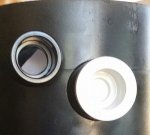I am about to embark on a DIY project of adding an auto fill to my pool... While I'm pretty handy and taking on such projects doesn't really scare me off, it would be helpful to know how such an installation typically takes place. My pool is about to be resurfaced and the resurfacing guys say just punch a hole through the shell and leave an inch + around the stub-out. Easy enough. And, I'm covering the existing cool-deck with pavers so whacking the cool-deck isn't an issue.
The auto fill comes with instructions but the piece that really isn't addressed is how to "mount" it in the soil. It has connection points to rebar which I assume is meant to keep it stationary... so here are my specific questions which I hope someone can help with:

Thanks for your thoughts!
The auto fill comes with instructions but the piece that really isn't addressed is how to "mount" it in the soil. It has connection points to rebar which I assume is meant to keep it stationary... so here are my specific questions which I hope someone can help with:
- Should the water supply coming into a slip joint on the bottom of the unit be a threaded elbow so in case of a later leak the pipe can simply be unthreaded and replaced, vs. glued (assume this is a good practice generally, with skimmers, etc)?
- How should the unit be mounted? Once plumbed does one merely backfill with soil... doesn't seem that would provide much support. I've read when replacing a skimmer soil (or sand) is backfilled to a point above the plumbing fittings on the bottom, rebar is drilled into the shell for support, and a form is built around the skimmer and filled with concrete. Is the process similar with the autofill? The autofill is somewhat different in that it has an overflow outlet at the top of the autofill which I suppose could be encased in concrete, or stop the concrete below that point.
- Separately but related, I live in the Phoenix area... and the water is very hard. I was thinking that I might get a softener for my home and supply the autofill with the softened water... thinking that since there is so much calcium in the water here, and evaporation is such a factor, the calcium concentration would stay relatively constant if topping off with softened water...
- any Idea what the sealed white port is for in the pic below? perhaps some other configuration... the adjacent black port is for overflow.

Thanks for your thoughts!

